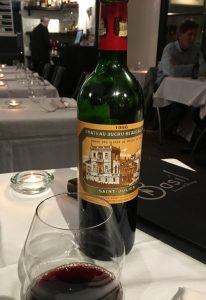
1996 Château Ducru-Beaucaillou, Second Growth, Saint-Julien, Red Bordeaux, France.
After holding this bottle for almost a decade, I just couldn’t wait any longer to pop the cork on this Ducru-Beaucaillou 1996, and I found it was in a lovely place and drinking fabulous with a distinct core of beautiful dark fruits that is fresh, but having the pretty maturity that age brings with tannins holding firm still, but allowing graceful textures and complete enjoyment. After Château Léoville Poyferré, which has become since 2001 one of my secret favorite Bordeaux(s), Château Ducru-Beaucaillou is one of the best Saint-Julien producers and has a long proven track record that while has a few blights along the way is pretty reliable for stylish and refined wines.
The estate, owned since 1941, by the Borie family, who purchased the historic Château Ducru-Beaucaillou and vineyards during the early part of WWII, with the wines having been produced here of enough quality to be classified as one of fifteen Deuxièmes Crus (Second Growths) in the original Bordeaux Wine Official Classification of 1855. The origins of Château Ducru-Beaucaillou dates back to 1720 to be precise, before Bertrand Ducru bought the estate and added his name to it, It owes its original name to the “beaux et gros cailloux” – the beautiful stones, referring to the gravelly soils of the outer Medoc. Château Ducru-Beaucaillou is now run by Bruno Borie, who’s family also owns two other premier estates, Château Grand-Puy-Lacoste and Château Haut-Batailley, both in the Pauillac region, all of which are Cabernet Sauvignon dominated, with Ducru-Beaucaillou being 70% Cabernet Sauvignon and 30% Merlot, with their vines being close to 60 years old on average.
The Grand Vin of Château Ducru-Beaucaillou, according to the winery, is aged for 18 months in 50% to 80% new oak barrels according to the richness of the vintage, and I would guess this deeply colored1996 had the lower range of new wood as it doesn’t show any remnants of the new oak, being fined with egg whites and only lightly filtered before its bottling. All is done with the purpose to allow the more delicate natural to shine through here, while allowing the Cabernet Sauvignon to make its presence felt on the palate. This 1996 vintage, now in 2019, is a study in purity and is everything we want in a left bank wine, showing finessed layers of blackberry, plum and cherry fruit along with hints of creme de cassis, loamy earth, cedar as well as dried flowers, loose tobacco leaf, anise and a touch of leather. The Merlot has added a smooth density and mouth feel, it’s presence working perfectly to fill out the wine, playing second fiddle to the Cabernet Sauvignon is no shame in a wine this elegant and well crafted, it’s very impressive and should drink well for another half a dozen years.
($175-349 Est.) 94 Points, grapelive